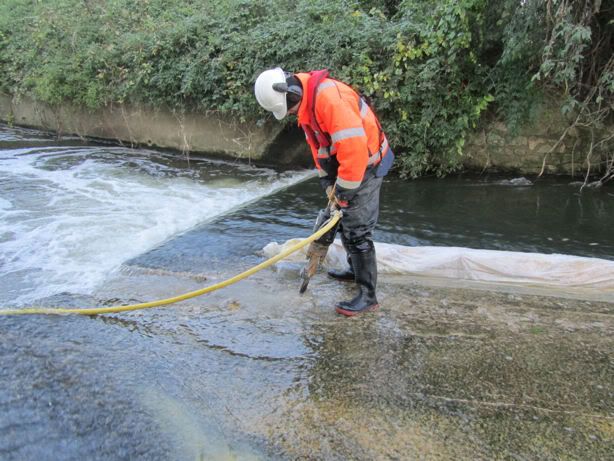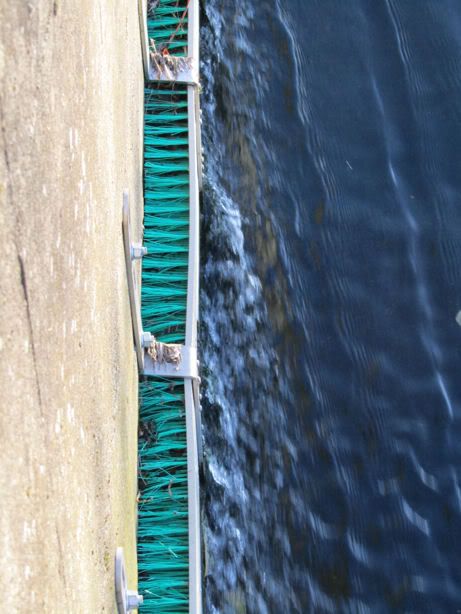Fisheries team shares their knowledge of Thames fish
The Thames Anglers’ Conservancy (TAC) has developed a strong working relationship with the Environment Agency’s fisheries team. As anglers, it is fascinating to listen to them, with their knowledge gained from electro-fishing, netting surveys and working daily on the river.
The TAC spoke to Tanya Houston, a fisheries team member based on the Thames:
Tanya, anglers are catching big carp along the Thames but we don’t hear many reports of junior carp being seen – 1 lb and under. Have any appeared in electro-fishing or netting surveys? If so, in what numbers and what sizes?
We don’t find young carp in our surveys. There are backwaters where carp may spawn but the juveniles could also be using these areas instead of the main river. We believe many of the larger carp in the Thames escaped from flooded gravel pits further upstream. Sounds like a good idea for a match to me!
Is the Thames or any of its tributaries stocked with carp by the EA?
No, we don’t stock carp into the Thames or its tributaries.
I understand the Thames starts getting brackish around Battersea. How far downstream do you know carp are confirmed to appear?
We have seen large carp quite far down the estuary, but this is normally due to being washed down. There have been occasional angler reports of carp captures from around Charlton. Commonly, we can catch them in surveys around Strand on the Green, downstream of Kew Bridge.
How far down the river coarse fish appear can depend on rainfall and, therefore, freshwater levels in the estuary but what coarse fish (not including eels) do you find surviving furthest downstream and how far downstream are they?
The eel fishermen fishing the lower estuary often pick up small pike and other species after rain storms or around creeks, but our main survey data suggests that we find bream, dace and roach as far down as Greenwich.
What is the current stocking policy for coarse fish in the Thames and its tributaries?
Generally we only carry out stocking of coarse fish in three circumstances: – 1. Following a pollution incident. 2. Where a new fishery has been created 3. Upstream of impassable obstructions.
The Thames tributaries in South London, however, are stocked annually to help them recover from past pollution events.
** The TAC helped the fisheries team stock hundreds of juvenile chub, roach and dace into the Beverley Brook and the Hogsmill tributaries. They were purposely stocked in November when the water is cold and oxygenated. The fish are bred at the EA’s fish farm in strong flow and cold water, to prepare them specifically for the conditions of these rivers. We’ve seen fish stocked from previous years now at healthy weights and can confirm that stocks are thriving and the restocking exercises are a success. **
Tanya, is there a water quality target for the Thames? If so, who is that target set by and how is the Thames doing against that target?
The water quality targets are set by European Directives such as the Urban Waste Water Treatment Directive and Water Framework Directive. These are achieved by regulation of industry, misconnections and controlling pollution. The best example of this is the work that Thames Water are doing to improve their three works on the Thames Tideway and the installation of an intercepting tunnel (currently under consultation).
Are there any stretches of the Thames that have a particularly low water quality reading and if so, why do you think this is?
Again the Thames Estuary can suffer from poor water quality in the summer. Combined Sewer Outfalls (CSOs) and Mogden storm discharges cause sudden and dramatic reductions in dissolved oxygen in the Richmond to Chelsea stretches, which can kill or affect fish health following rainfall. This is the most significant water quality issue in the estuary. Increasing the treatment capacity of Mogden and the Thames Tunnel will largely fix this problem.
Salmon are oft quoted as an indicator of water quality. What time of year do the salmon run up the Thames?
They are in the estuary between June and October. They will be in freshwater until they spawn between October and January in the upper reaches of the Thames.
What is the current thinking about stocking salmon in the Thames and its tributaries?
We no longer stock salmon in the Thames, but we continue to improve fish passage and influence water quality, enabling wild salmon entering the tideway to move upstream. Salmon returns have been poor in recent years but we are seeing a big increase in sea trout numbers in the Thames.
Is there a current stocking policy for trout?
We don’t stock trout in the Thames or any of its tributaries. But we do a lot to improve habitat, fish passage and water quality to enable wild brown trout to spawn naturally. The Wandle is an excellent example. We have good stocks of wild trout in rivers such as the Wey, Kennet, Tillingbourne, Chess, Upper Colne, Windrush and Cotswold streams and Lea tributaries.
There was a press release this year from the EA stating we’ve had record sea trout numbers in the Thames. What was this based on?
The records are collected by fish traps on some of the fish pass structures on the Thames initially put there to monitor returning salmon under the Salmon Scheme, they have been immensely useful in picking up other migrating salmonids. I believe we had over one hundred come through this year.
What time of year do the sea trout run up the Thames?
They will be in the estuary earlier in the year than salmon and spawn around October to December.
The TAC understands sea trout were spotted around the Hogsmill confluence with the Thames at Kingston and so work has been done to improve sea trout passage upstream. The EA appointed Land & Water, the engineering contractors, to notch out a channel in a Hogsmill weir to encourage them upstream to spawning grounds. This will, of course, also help other species.

‘Notching out’ a channel in a Hogsmill weir at Kingston to aid fish passage upstream
Tanya, anglers have heard of new eel byelaws. Please could you clarify the current law on fishing for eels on the Thames? When/where is it allowed and are anglers allowed to take any for the table or bait?
The new restrictions on fish taken by rod and line states that fishermen can no longer keep eels for any reason. It also sets out size and number of fish taken of other species under one set of byelaws.
The protection for eels has come in through different routes. The driving legislation has come in the form of a Statutory Instrument under the European Eel Byelaws which states there must be improvements in habitat and passage as well as a reduction of exploitation. Restrictions are also being placed on the commercial eel and elver fisheries and should be confirmed soon.
The Environment Agency has also written eel management plans for river basin districts across England and Wales to assess the current stock on the data available, and recommend further surveys and priority sites for works.
Are eel numbers still going down in the Thames?
European wide recruitment of elvers has been falling. This has not been obvious in the Thames fishermen’s catches, but monitoring of the fish populations has noted a reduction in larger eels in the upper freshwater Thames and tributaries.
I am not aware of any increases in populations elsewhere, but there is also a massive lack of data on eels as they were not always measured during routine surveys across the country (luckily they were counted in Thames) and they are also good at avoiding the electric fishing gear.
In the Thames, the fisheries teams are working hard to improve eel passage and habitat in schemes run by our colleagues in flood defense, planning applications and by our own small projects. For example in Kingston on the Hogsmill we have placed an eel pass on the side of a gauging weir that cannot be removed.

Hogsmill eel pass in Kingston. Elvers use the bristles to gain grip as they make their way up the eel pass, safely bypassing the weir
Other than the well publicised eel problems, are there any other species in the Thames that is in specific difficulty?
As a recovering system we are still not entirely sure what should be at which level. We are certain that fish like dace and flounder are using the Thames for a lot or all of their lifecycle but fish like salmon and lamprey are still struggling to complete their lifecycles due to water quality and migration barriers.
Are there any species in the Thames that your surveys show are in particular increasing abundance?
We have observed large number of smelt in our surveys this year, and that has been echoed by other monitoring projects in the estuary. Our surveys cannot identify a change in ‘abundance’ as they are simply a snapshot of the estuary, but it is encouraging to see a rise in smelt due to their sensitivity to water quality.

Smelt were in abundance this year in the Thames in freshwater up to Richmond. Each one netted was measured, recorded then returned
Tanya, thank you for involving the TAC in Thames events. You’ve invited us to fish surveys on the Thames and restockings on the Beverley Brook and Hogsmill tributaries. You also presented on some of the work your team does at our TAC meeting. Is there anything as a club we can do to help the Thames fisheries team?
It is useful to hear what anglers perceive as the most important thing to them for us to do which the TAC have been giving us a boost on since it was conceived last year. The feedback we get from TAC is invaluable to us. We’re hoping we can work together more in the future.
Also, anglers promptly reporting illegal fishing or pollution incidents on our emergency number 0800 80 70 60 will help us deal with incidents more effectively.
Thanks for sharing your knowledge with us Tanya. We’ll be sure to give you feedback from our members.
Steve Holmes – Thames Anglers' Conservancy
This entry was posted in
News and tagged
Environment Agency,
TAC. Bookmark the
permalink.




